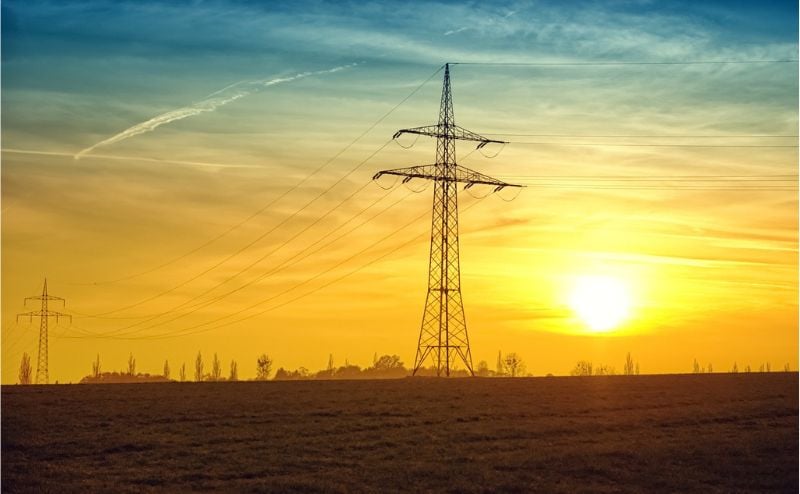U.S. Grid Operators Behind in Deploying HVDC Technology
A European report outlines strategies to assist North American grid engineers in implementing high-voltage direct current transmission.
Power engineers working on grid modernization projects throughout the United States find an increasing number of these initiatives involve high-voltage direct current (HVDC) transmission technology.
HVDC power lines. Image used courtesy of Pixabay
Even so, the United States has made less progress than other nations embracing this option. Conquering the adoption-related barriers will take time, but it’s possible through concentrated efforts.
Taking Inspiration From Europe
Grid engineers in Europe have progressively transitioned to HVDC technology with voltage source converters (VSC). A study sponsored by the American Council on Renewable Energy, Allete, Clean Grid Alliance, GridLab, Pattern Energy Group, and Grid United examines how to remove barriers preventing the same progress in the United States.
The report found Europe boasts approximately 50 gigawatts of operational projects, with another 130 gigawatts planned over the next decade. In contrast, North America accounts for just 3% of VSC-based HVDC projects worldwide. Although the report’s summary does not specify Europe’s percentage, it positions the continent as a leader in this area.
The coverage mentions notable projects, including new HVDC backbone transmission projects representing 10 gigawatts in Germany and a case in Scotland representing five sets of 2-gigawatt HVDC backbone equipment orders. Such projects can inform engineers’ HVDC transmission overlay decisions, allowing them to learn about procurement and installation options.
In another example, in early 2023, Dutch-German transmission system operator TenneT hired Hitachi Energy and Petrofac to handle preparations and give engineering recommendations regarding developing offshore converter stations for an HVDC expansion of offshore wind power. The agreement between the parties started the detailed engineering plans for two 2-gigawatt projects scheduled to begin operating in 2029 and 2030.
Offhore wind project. Image used courtesy of Petrofac
As power engineers monitor the developments in projects like these, they can identify best practices or trends to apply to their work. Learning from the decisions of those more experienced in HVDC projects can allow engineering professionals to see what works best and avoid mistakes.
Reserving Time for HVDC Training
The report also suggested energy industry stakeholders collaborate to share their knowledge and train engineers and other involved parties. Proactive engineering professionals may wish to get ahead of the curve by taking one of the many HVDC courses that give them professional development hours for completion. Some educational providers publish e-learning content, offering ideal solutions for engineers without local options who cannot easily travel to a training center. The modules cover everything from HVDC principles to technologies, providing learners with current and actionable knowledge.
Other courses focus primarily on underground cables, which many engineers consider more reliable than above-ground infrastructure. Statistics from 2011 to 2021 indicated a 78% jump in power outages caused by weather compared to the previous decade. HVDC cables are well-protected from storm effects once buried, making them important for grid updates.
Analysis of power outages over the past decade. Image used courtesy of EIA
Part of the report’s summary noted how insufficient technology standards hinder efforts to expand HVDC projects in the United States. However, IEEE 1378-2022 is the existing framework providing commissioning guidelines for HVDC converter stations and transmission systems.
The IEEE SA Standards Board is also working on a guidance document for VSC-based systems. Once completed, it will include functional details about specifics such as frequency and voltage regulation, fault recovery, and current accepted engineering practices. Engineers who set aside time to study and refer to such materials will be well-equipped to help the United States catch up in HVDC deployment.
Understanding HVDC Developments in the US
Although the United States has yet to progress as much as Europe in modernizing the grid with HVDC technology, efforts are still occurring, and engineers should pay attention to them. One initiative is Pattern Energy’s 3-gigawatt SunZia transmission project. It’s one of the world’s largest renewable energy sources and will connect New Mexico to power grids in California and Arizona. Representatives from Hitachi Energy have assumed engineering and design responsibilities for the two HVDC light converter stations.
Path of Pattern Energy’s SunZia transmission project. Image used courtesy of Pattern Energy
Elsewhere, WSP USA will provide engineering services for an offshore HVDC converter platform associated with New York’s Sunrise Wind Farm. The company’s professionals will verify that the devised solution complies with the United States’ standards and codes. Since this project is the first HVDC wind farm in the country, it will undoubtedly provide valuable learning opportunities for engineers worldwide.
Action is happening at the federal level, too. In September 2023, the U.S. Department of Energy allocated $10 million to support innovation and cost-minimization strategies for HVDC VSC technologies. It’s the first step toward the department’s goal to achieve a 35% reduction in system costs, which should promote wider adoption.
This funding opportunity announcement focuses on enhancements, including:
- Increased power capacity for converters
- Decreased converter substation sizes
- Lengthening system life spans
Many of the received proposals could illuminate new opportunities for further research and development for HVDC technology.
HVDC for Renewable Energy
Although the United States has some catching up to do in its deployment of HVDC systems, engineers have examples within and outside the U.S. to inform their methods and decisions. These pioneering projects will set the tone for grid upgrades and broadening renewable energy efforts.










